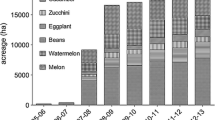Abstract
After biological control of Tetranychus urticae using Phytoseiulus persimilis, a latent mite pest, Eotetranychus asiaticus, was found on strawberries growing in a plastic greenhouse in western Japan. To determine whether the release ofP. persimilis, an exotic natural enemy of T.urticae, enhanced the occurrence of the latent pest, the efficiency of P. persimilis in controlling E.asiaticus was compared with the efficiency of two indigenous phytoseiid mites, Amblyseius californicus and A. womersleyi, under laboratory conditions. Phytoseiuluspersimilis and A. californicus attacked not onlyT. urticae but also E. asiaticus. However, the predators produced very few eggs and their offspring rarely reached adulthood when fed on E. asiaticus, so their potential as control agents for the latent mite appears to be low. In contrast, A.womersleyi feeding on E. asiaticus reproduced as well as when fed on T. urticae, and exterminated both species of spider mite. This suggests that A. womersleyihas greater potential as a biological control agent in crops where both species may occur.
Similar content being viewed by others
Author information
Authors and Affiliations
Rights and permissions
About this article
Cite this article
Osakabe, M. Which predatory mite can control both a dominant mite pest, Tetranychus urticae, and a latent mite pest, Eotetranychus asiaticus, on strawberry?. Exp Appl Acarol 26, 219–230 (2002). https://doi.org/10.1023/A:1021116121604
Issue Date:
DOI: https://doi.org/10.1023/A:1021116121604




